DODGE SPRINTER 2004 1.G Service Manual
Manufacturer: DODGE, Model Year: 2004, Model line: SPRINTER, Model: DODGE SPRINTER 2004 1.GPages: 272, PDF Size: 22.71 MB
Page 41 of 272
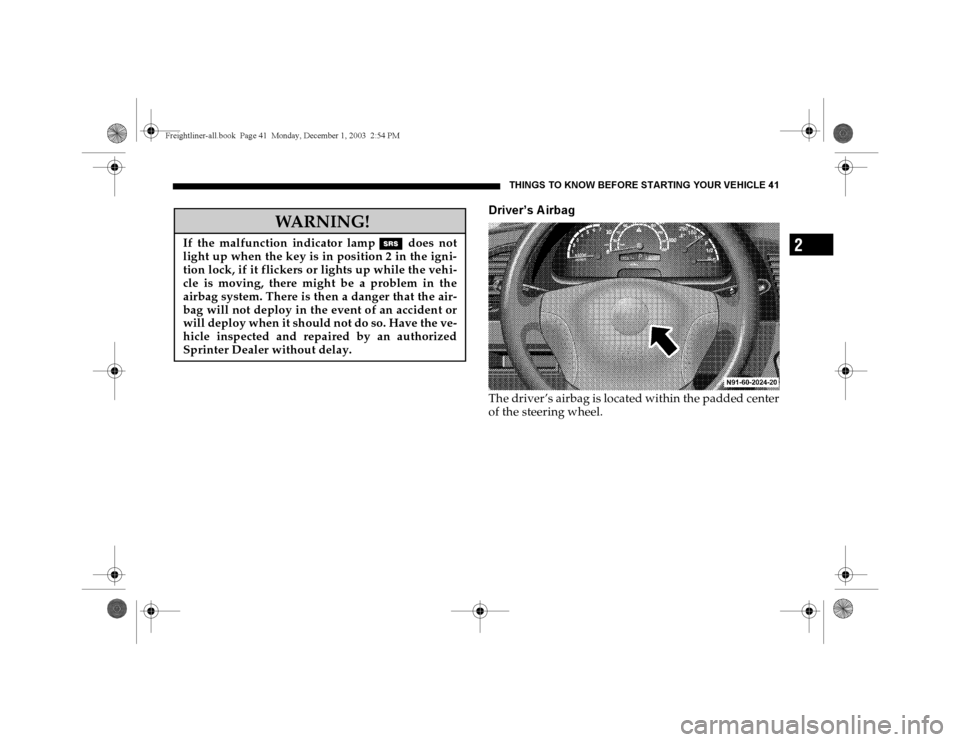
THINGS TO KNOW BEFORE STARTING YOUR VEHICLE 41
2
Driver’s A irbagThe driver’s airbag is located within the padded center
of the steering wheel.
WARNING!
If the malfunction indicator lamp1 does not
light up when the key is in position 2 in the igni-
tion lock, if it flickers or lights up while the vehi-
cle is moving, there might be a problem in the
airbag system. There is then a danger that the air-
bag will not deploy in the event of an accident or
will deploy when it should not do so. Have the ve-
hicle inspected and repaired by an authorized
Sprinter Dealer without delay.
Freightliner-all.book Pag e 41 Monday , December 1, 2003 2:54 PM
Page 42 of 272
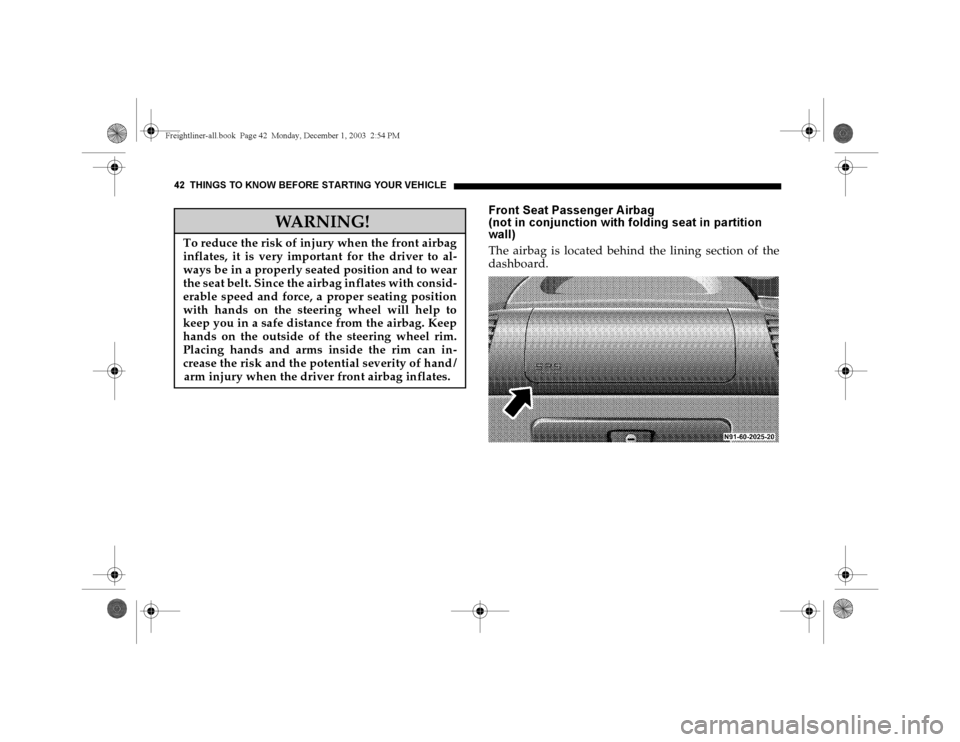
42 THINGS TO KNOW BEFORE STARTING YOUR VEH ICLE
Front Seat Passenger A irbag
(not in conjunction with folding seat in partition
wall)The airbag is located behind the lining section of the
dashboard.
WARNING!
To reduce the risk of injury when the front airbag
inflates, it is very important for the driver to al-
ways be in a properly seated position and to wear
the seat belt. Since the airbag inflates with consid-
erable speed and force, a proper seating position
with hands on the steering wheel will help to
keep you in a safe distance from the airbag. Keep
hands on the outside of the steering wheel rim.
Placing hands and arms inside the rim can in-
crease the risk and the potential severity of hand /
arm injury when the driver front airbag inflates.
Freightliner-all.book Pag e 42 Monday , December 1, 2003 2:54 PM
Page 43 of 272

THINGS TO KNOW BEFORE STARTING YOUR VEHICLE 43
2
Belt TensionersThe belt tensioners are located on the three-point seat
belts of the driver’s and front passenger seats.
The belt tensioners will not operate unless the key has
been turned to position 1 or 2 in the ignition lock.
The airbag and / or belt tensioners are designed to only
trigger in certain frontal impacts as not all accidents
call for airbag and / or belt tensioner deployment.
WARNING!
To reduce the risk of injury when the front airbag
inflates, it is very important for the passenger to
always be in a properly seated position and to
wear the seat belt. Since the airbag inflates with
considerable speed and force, a proper seating po-
sition will help to keep you in a safe distance from
the airbag.
Do not place any pieces on the top of the
mounting lid above the airbag. If the airbag is
activated the pieces could be thrown into the
passenger compartment. This could result in
severe personal injuries and death.
Freightliner-all.book Pag e 43 Monday , December 1, 2003 2:54 PM
Page 44 of 272
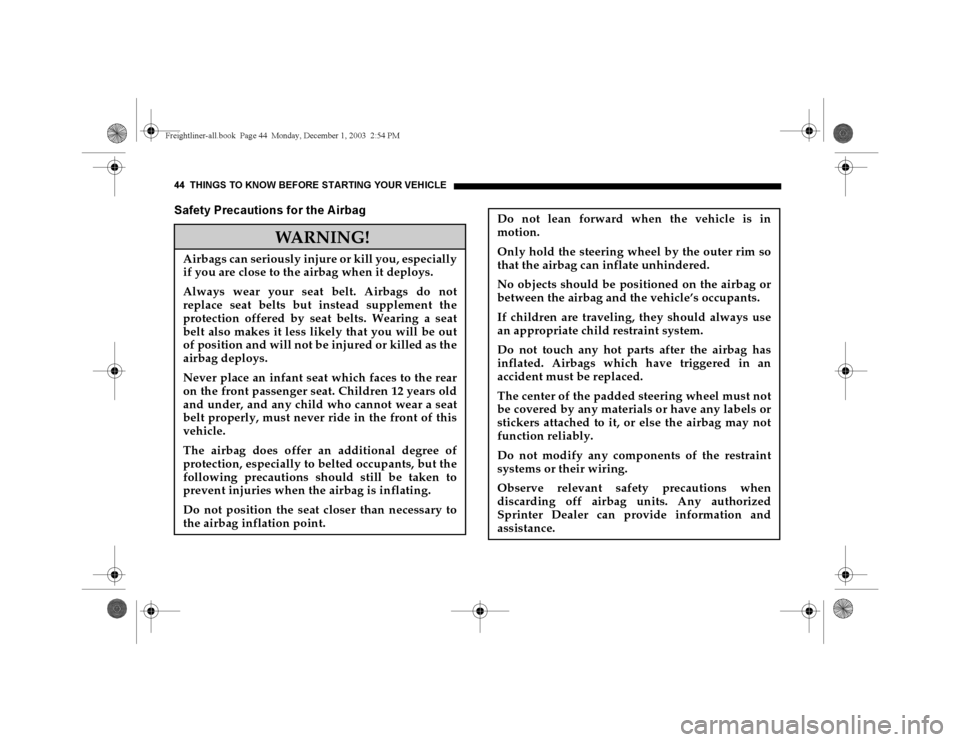
44 THINGS TO KNOW BEFORE STARTING YOUR VEH ICLESafety Precautions for the A irbag
WARNING!
Airbags can seriously injure or kill you, especially
if you are close to the airbag when it deploys.
Always wear your seat belt. Airbags do not
replace seat belts but instead supplement the
protection offered by seat belts. Wearing a seat
belt also makes it less likely that you will be out
of position and will not be injured or killed as the
airbag deploys.
Never place an infant seat which faces to the rear
on the front passenger seat. Children 12 years old
and under, and any child who cannot wear a seat
belt properly, must never ride in the front of this
vehicle.
The airbag does offer an additional degree of
protection, especially to belted occupants, but the
following precautions should still be taken to
prevent injuries when the airbag is inflating.
Do not position the seat closer than necessary to
the airbag inflation point.
Do not lean forward when the vehicle is in
motion.
Only hold the steering wheel by the outer rim so
that the airbag can inflate unhindered.
No objects should be positioned on the airbag or
between the airbag and the vehicle’s occupants.
If children are traveling, they should always use
an appropriate child restraint system.
Do not touch any hot parts after the airbag has
inflated. Airbags which have triggered in an
accident must be replaced.
The center of the padded steering wheel must not
be covered by any materials or have any labels or
stickers attached to it, or else the airbag may not
function reliably.
Do not modify any components of the restraint
systems or their wiring.
Observe relevant safety precautions when
discarding off airbag units. Any authorized
Sprinter Dealer can provide information and
assistance.
Freightliner-all.book Pag e 44 Monday , December 1, 2003 2:54 PM
Page 45 of 272

THINGS TO KNOW BEFORE STARTING YOUR VEHICLE 45
2
Make sure to give any new owner of your vehicle
this Owner’s Manual so that the new owner will
be aware of all safety warnings.
If the instrument cluster indicates a malfunction
of the "SRS", as explained above, we strongly
recommend that you visit an authorized Sprinter
Dealer immediately to have the system checked;
otherwise the "SRS" may not be activated when
needed in an accident, which could result in
serious or fatal injury, or it might deploy
unexpectedly and unnecessarily, which could also
result in injury or death.
The activation of the "SRS" temporarily releases a
small amount of dust from the airbag. This dust,
however, is neither injurious to your health, nor
does it indicate a fire in the vehicle. The dust
might cause some temporary breathing difficulty
for people with asthma or other breathing trouble.
To avoid this, you may wish to get out of the
vehicle as soon as it is safe to do so. If you have
any breathing difficulty but cannot get out of the
vehicle after the airbag inflates, then get fresh air
by opening a window or door.
Given the considerable deployment speed and the
textile structure of the airbag, there is a risk of
abrasions and injuries due to airbag deployment.
Freightliner-all.book Pag e 45 Monday , December 1, 2003 2:54 PM
Page 46 of 272
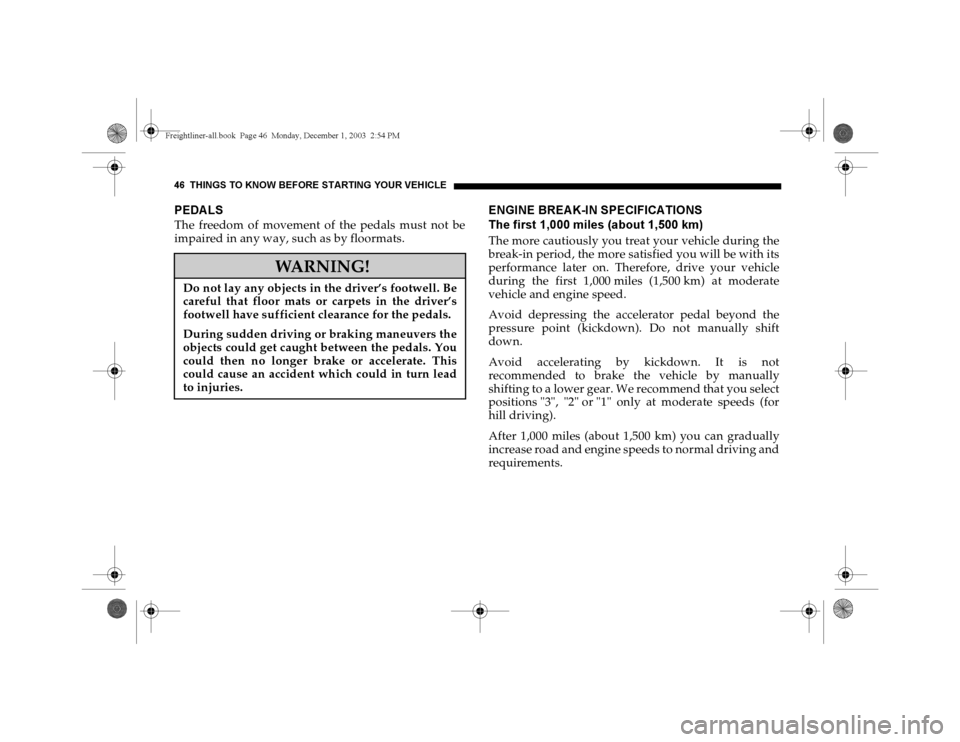
46 THINGS TO KNOW BEFORE STARTING YOUR VEH ICLEPEDALSThe freedom of movement of the pedals must not be
impaired in any way, such as by floormats.
ENGINE BREAK-IN SPECIFICATIONS
The first 1,000 miles (about 1,500 km)The more cautiously you treat your vehicle during the
break-in period, the more satisfied you will be with its
performance later on. Therefore, drive your vehicle
during the first 1,000 miles (1,500 km) at moderate
vehicle and engine speed.
Avoid depressing the accelerator pedal beyond the
pressure point (kickdown). Do not manually shift
down.
Avoid accelerating by kickdown. It is not
recommended to brake the vehicle by manually
shifting to a lower gear. We recommend that you select
positions "3", "2" or "1" only at moderate speeds (for
hill driving).
After 1,000 miles (about 1,500 km) you can gradually
increase road and engine speeds to normal driving and
requirements.
WARNING!
Do not lay any objects in the driver’s footwell. Be
careful that floor mats or carpets in the driver’s
footwell have sufficient clearance for the pedals.
During sudden driving or braking maneuvers the
objects could get caught between the pedals. You
could then no longer brake or accelerate. This
could cause an accident which could in turn lead
to injuries.
Freightliner-all.book Pag e 46 Monday , December 1, 2003 2:54 PM
Page 47 of 272

THINGS TO KNOW BEFORE STARTING YOUR VEHICLE 47
2
Engine Oil ConsumptionWhen the engine has passed the break-in period, oil
consumption may reach 0.5 % of the fuel consumption
recorded in actual operating circumstances. In isolated
cases and in arduous operating conditions, oil
consumption may increase to 1 % of the fuel
consumption recorded in actual operating
circumstances.
Engine oil consumption depends on the driving style
adopted and the operating conditions. It can only be
judged after the engine has passed the break-in period.
For engine oil level.SA FETY TI PS Check the vehicle’s lights and the general condition
of the vehicle before each trip.
Keep tires at the recommended inflation pressure.
All occupants should fasten their seat belts before
each trip.
Driving in an environmentally responsible manner
will reduce noise, fuel consumption and exhaust
emissions. Allow the engine to warm up under low load use.
Avoid unnecessarily hard acceleration, driving with
the throttle fully open, and carrying loads not
specifically needed on the journey.
Stop the engine during lengthy waiting periods, for
example at traffic lights.
Remove ancillary parts, such as wind deflectors and
roof racks, as soon as they are no longer needed.Freightliner-all.book Pag e 47 Monday , December 1, 2003 2:54 PM
Page 48 of 272

48 THINGS TO KNOW BEFORE STARTING YOUR VEH ICLEINHA LA TION OF EXHA UST GA S TIE DOWN RINGS (OPTIONA L)
1. Tie Down Rings
The rings (1) are used to attach the load with the help
of tension belts. Place the tension belt around the load,
secure it on the rings (1) and tie it down.
WARNING!
Inhalation of exhaust gas is hazardous to your
health. All exhaust gas contains carbon monoxide
and inhaling it can cause unconsciousness and
lead to death.
Do not run the engine in confined areas (such as a
garage) which are not properly ventilated. If you
think that exhaust gas fumes are entering the
vehicle while driving, have the cause determined
and corrected immediately. If you must drive
under these conditions, drive only with at least
one window fully open.
Freightliner-all.book Pag e 48 Monday , December 1, 2003 2:54 PM
Page 49 of 272
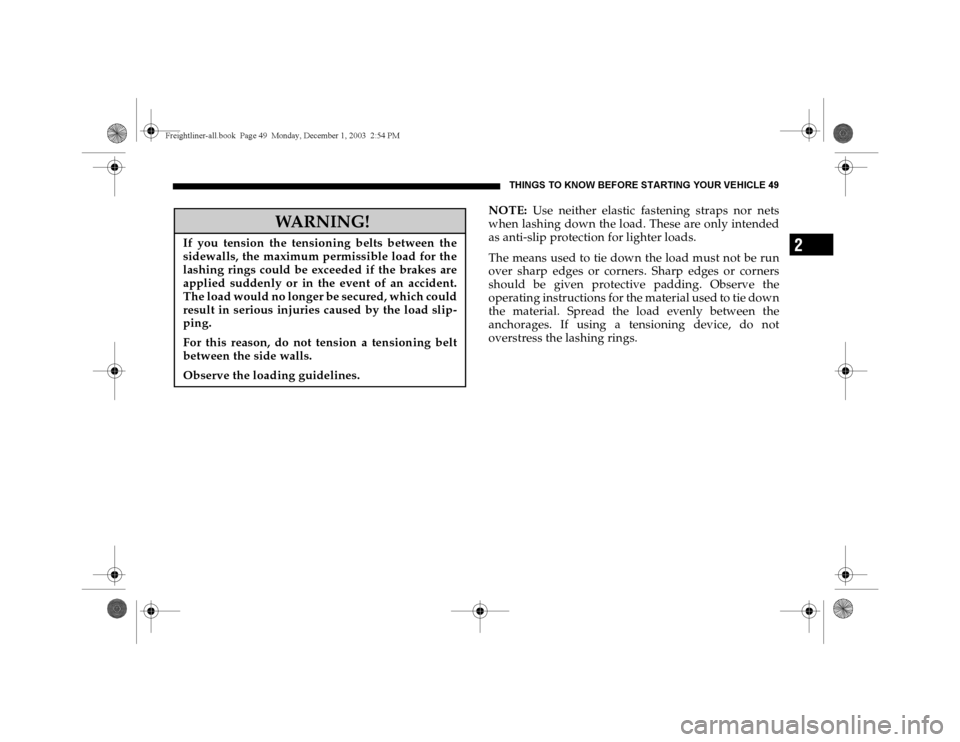
THINGS TO KNOW BEFORE STARTING YOUR VEHICLE 49
2
NOTE: Use neither elastic fastening straps nor nets
when lashing down the load. These are only intended
as anti-slip protection for lighter loads.
The means used to tie down the load must not be run
over sharp edges or corners. Sharp edges or corners
should be given protective padding. Observe the
operating instructions for the material used to tie down
the material. Spread the load evenly between the
anchorages. If using a tensioning device, do not
overstress the lashing rings.
WARNING!
If you tension the tensioning belts between the
sidewalls, the maximum permissible load for the
lashing rings could be exceeded if the brakes are
applied suddenly or in the event of an accident.
The load would no longer be secured, which could
result in serious injuries caused by the load slip-
ping.
For this reason, do not tension a tensioning belt
between the side walls.
Observe the loading guidelines.
Freightliner-all.book Pag e 49 Monday , December 1, 2003 2:54 PM
Page 50 of 272

Freightliner-all.book Pag e 50 Monday , December 1, 2003 2:54 PM